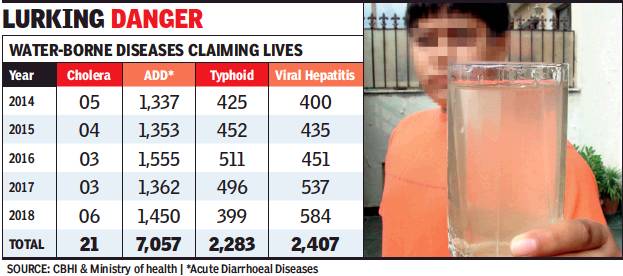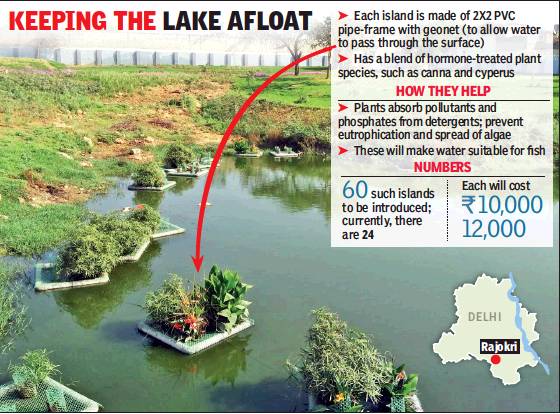Water pollution: India
This is a collection of articles archived for the excellence of their content. |
Contents |
Impact on health, longevity
2014-18
Chethan Kumar, June 29, 2019: The Times of India

From: Chethan Kumar, June 29, 2019: The Times of India
Stories about millions of Indians struggling for water have caught the world’s attention but here’s a grave story about those who have had access to water. Notwithstanding available vaccines and medicines, polluted water killed seven people a day in India in 2018, while at least 36,000 people were diagnosed with water-borne diseases every day.
In 2018, 2,439 people died because of four major water-borne diseases — cholera, acute diarrhoeal diseases (ADD), typhoid and viral hepatitis. In all, more than 1.3 crore people were diagnosed with these diseases.
As per this data, accessed from the Central Bureau of Health Intelligence (CBHI) and the ministry of health and family welfare, ADD — known to affect children below five years the most — was the biggest killer, accounting for 1,450 (60%) of the 2,439 deaths in 2018.
In the past five years, 11,768 people have died of these diseases one every four hours on average — while 7.6 crore people were diagnosed with them during the same time. The trend of ADD claiming the most lives, followed by hepatitis, is common to all five years. Hepatitis killed 584 people in 2018.
Healthcare Access
Dr M K Ramesh, dean at Bangalore Medical College and Research Institute, sees it as a healthcare problem. “While it is established that several people do not have access to potable water, this is a problem of lack of access to healthcare. Today, there are medicines for all these diseases, but if people are still dying, it’s because they cannot avail it.”
Dr Ajith Benedict Rayan, who has been practising for nearly 30 years, had earlier told TOI that overuse of antibiotics was another major reason for the deaths. He had said that in many cases patients are taking antibiotics even when not required which results in temporary relief while the actual disease still persists, which could also be killing more people.
Arguing that while the government is spending a lot of money on tertiary health centres (hospitals), Ramesh says it needs to focus on primary healthcare. “Hospitals like Bowring, Victoria, or even BMCRI, are all tertiary healthcare centres but nearly 80% of the patients visiting them are coming for primary healthcare issues. This shows that the PHCs (primary healthcare centres) are not working optimally,” he said.
Dependence & Pollution
According to CBHI and the ministry, all these diseases are caused by contaminated water. Separate data accessed from the Central Pollution Control Board (CPCB) shows that 50% of the 620 districts in India have contaminated groundwater, while data from the ministry of water resources shows that 56% of Indians depend on groundwater for their needs. A senior scientist with the water resources ministry said there were two kinds of pollution: geogenic (caused by nature) and anthropogenic (man-made). Chemicals like fluoride and arsenic are largely geogenic although some industries also contribute to such pollution. Overall there is a problem of water and that is because of over exploitation.
Reverse Osmosis (RO) purifiers
’ Ban ROs where TDS is within range’: NGT
Nov 7, 2019: The Times of India
The National Green Tribunal (NGT) has rapped the ministry of environment, forest and climate change (MoEFCC) for the delay in issuing a notification to ban the usage of Reverse Osmosis (RO) purifiers in areas where total dissolved solids (TDS) are within the permissible limits.
Slamming the ministry for failing to comply with the NGT’s previous order dated May 20,2019, a bench headed by NGT chairperson Justice Adarsh Kumar Goel gave the MoEF time until December 31, 2019, following which the officer in-charge concerned will not be entitled to draw a salary, until compliance is met.
“The officers present have not shown any valid reason for non-compliance. The order of this tribunal dated May 20, 2019 is a binding decree under Section 25 of the National Green Tribunal Act, 2010, and the officers of MoEF are liable to be proceeded against for non-compliance,” the bench said.
“Accordingly, we give last opportunity to comply with the directions already issued latest by December 31, 2019, failing which from January 1, 2020, the concerned officer(s) incharge in MoEF&CC will not be entitled to draw salary till the order of this tribunal is complied,” the tribunal added.
The green tribunal said that it will review the action on January 10. The bench also observed that the Central Ground Water Authority had filed the requisite data to the CPCB, as directed, which will explain how wastage of water was being checked. The NGT in May had directed the government to prohibit use of RO purifiers where total dissolved solids in water were below 500 mg per litre and sensitise public about the ill-effects of demineralised water.
Solutions
Floating islands on Delhi’s Rajokri lake
Paras Singh, April 4, 2019: The Times of India

From: Paras Singh, April 4, 2019: The Times of India
CLEAN-UP ACT: Hormone-Treated Plants Soak Up Pollutants, Purify Water In Wetland
People living on the periphery of Rajokri lake in the Southern Ridge were bewildered this past week to see green islands floating in the water. Unknown to them, Delhi Jal Board had quietly introduced these “purification islands” to soak up pollutants and purify the water in the wetland that was rejuvenated last year. The islands are knots of hormone-treated plants.
Ankit Srivastava, advisor to DJB, explained that the 2x2-metre rafts have a framework of PVC pipes lined with geonetting to support the plants like cyperus and canna. “A mix of different hormone-treated plants is used on each float to increase the nutrient uptake,” he said. The hormones act as the catalysts for the rapid growth of plants, which feed on the pollutants present in the lake water. This in-house innovation can make water suitable enough to introduce fishes and make the lake ecosystem self-cleaning.
Each raft costs around Rs10,000, including maintenance for a year. Around two dozen such islands have been introduced and DJB plans to have 60 ultimately. The National Environmental Engineering Research Institute created the framework for the floats, but vendors are now manufacturing it. A similar experiment is being carried out at the Hauz Khas lake, where algal bloom has turned the water green.
“The lake at Rajokri was still receiving pollutants like detergent from rainfall and other sources,” a DJB official said. “The plants absorb trace pollutants and the phosphates from detergents, and prevent excess nutrients in the lake leading to algal bloom.”
Besides the floaters, DJB has also given the financial goahead to the addition of two tertiary levels for water flowing from constructed wetland. The Rajokri lake rejuvenation is based on the SWAB technology in which raw sewage feeds the lake after passing through a sedimentation tank, digesters and a gravel-lined zig-zag wetland during which the unwelcome organic matter in the water is reduced to an acceptable level.
“A carbon-sand filter will be added, while on-site aeration units have also been sanctioned. Our aim is to bring the biological quality of the water to levels that will create an ideal environment for fish to flourish,” the official explained. Since December last year, the lake has shown strong signs of recovery, helping groundwater levels rise and attracting birds.